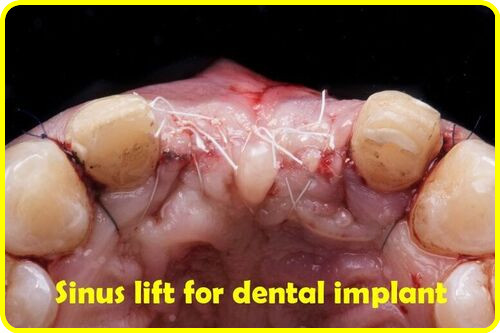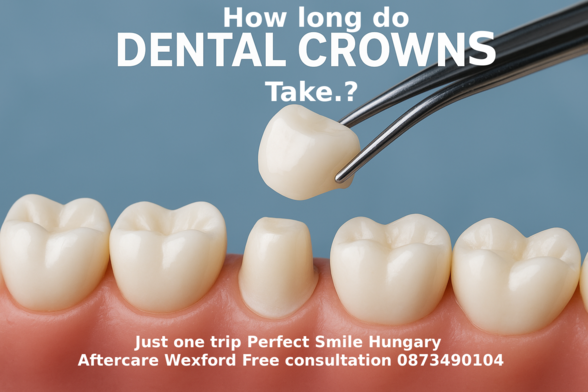Sinus lift for dental implant
In this article we are going to look at a sinus lift for dental implant, what is a sinus lift, why have a sinus lift, what are the different types of sinus lift for dental implant, what materials are used for a sinus lift, what are the risks, what happens if a sinus lift dental implant isn’t completed, what happens during the treatment.

The sinus lift procedure
A sinus lift is a common enough dental procedure used by dental surgeons to maximize the amount of bone needed under the upper (maxillary) jaw to allow a dental implant to be placed there.
The sinuses in your upper jaw are lined by space filled with air, they lie next to your nose, they are positioned above the molar and premolar and just below the eye. Inside the sinus is a bone that is lined with a thin membrane.
Basically, the dental surgeon will raise or lift this thin membrane to make space for bone and a dental implant, a sinus lift procedure is carried out just before or it can be at the same time as the dental implant placement.
A closer look at a sinus lift for dental implant
Let’s take a closer look at a sinus lift for dental implant, including what other options ate available to patients, the potential benefits and risks, why consent is needed for a sinus lift dental implant.
Why get a sinus lift dental implant
A lot of people that unfortunately have lost the back teeth from the upper jaw simply don’t have sufficient bone to take a dental implant.
A sinus lift dental implant offers the opportunity to create enough bone underneath the sinus so that an implant can be positioned near the back of the upper jawbone, the bone is fixed in between the sinuses and the jaw.
The length of time needed for this sinus lift to a dental implant being fitted will vary, anywhere between six to twelve months or longer.
What materials are used in a sinus lift
A number of sources are used for bone grafting material that include the patient, other humans, animal or synthetic, the material used for grafting produces a type of scaffold that allows your own bone grow into, the sinus lift for dental implant procedure can take between four to twelve months.
Bio-OSS is the most commonly used sinus lift material, basically it is artificially sterilized bone taken from cattle that is safe to use in humans, in addition to protect the bone graft a membrane will be placed over it.
The membrane that is most commonly used is called Bio-Gide, it is made from porcine and is dissolvable, should you have any concerns concerning the sinus lift dental for implant procedure speak to your dental surgeon.

Sinus lift risks
The main risk concerns the membrane, it could tear or puncture, should this happen the surgeon may stitch it back or place a patch over it, if this doesn’t work out the tear may be allowed time to heal.
Following the healing, the surgeon may do the sinus lift dental implant again, this won’t take place for a minimum of two months because the healed membrane needs to be stronger and thicker.
In some cases patients may experience a nose bleed, sinuses may feel blocked for a number of weeks after surgery, in a very small number of cases vertigo can happen but it is temporary.
In about 2.9% of cases the gum can become infected, after 2 to seven days facial pain and swelling may be evident, after one to three days severe bruising to the face may be evident, there is a high success rate, however if you smoke the rate of success drops by 1.9%.
Minimize risks during sinus lift
In a case of severe pain, the most obvious answer us to use painkillers, as difficult as it sounds no nose blowing for two weeks following the procedure, inhale hot water infused with menthol 3 times daily for 10 days, prescribed antibiotics or decongestants.
With any surgical procedure there are risks, then you have to give the healing process time,
- Pain will be controlled using paracetamol or ibuprofen
- Swelling at its maximum for 48 hours
- The cheek and lower jaw will be bruised
- Stitches will be removed after 10 days
- Gums should feel normal within 3 weeks
What happens if a sinus lift isn’t completed
The patient always has the choice whether to have a sinus lift dental implant or not, its important to understand the alternatives to a sinus lift for dental implant, if you have missing teeth and need a sinus lift the options are:
A reduced size implant
A reduced size or shorter implant could be possible without the need for a sinus lift, however the chances of success diminish as the size of the implant reduces, a number of reduced size implants may work, success rates are high however the risk of complications increases.
Placing fewer implants more forward
The second option is placing less implant but in a further forward position, this option will replace fewer teeth on a bridge that fixes to the implants, or acts as a replacement for teeth that sit on a removable denture that is clipped to the implants.
Having fewer implants means that when you chew and bite through the implants it could cause complications more frequently on the dentures, bridges or implants.
A bridge fixed to adjoining teeth
This alternative to a sinus lift for dental bridge means that the dentist will glue a resin bridge onto an adjoining tooth or he will file down the adjoining tooth to allow a dental crown to be fitted, a decision on this procedure will be made based on the adjoining tooth quality, the distance if the span, the bite, and the state if the pulse or root canal.
Dentures as an option
Are dentures a possible option to a sinus lift dental implant, only if an implant or bridge doesn’t work, a denture will replace missing teeth however they will need to be taken out for cleaning each night.

Pterygoid and Zygomatic implants
Pterygoid and Zygomatic implants can be positioned onto facial bones that lie at the back of the upper jaw, these are quite long and at an angle so that they are placed into the mouth for restoration on either a fixed bridge or a removable denture.
This type of surgery is much more complicated that a conventional sinus lift dental implant procedure, not all dental clinics can offer this procedure.
Don’t replace any teeth
Should there not be enough teeth that function properly then accepting the gaps may be the best option.
Preparation for a sinus lift dental implant
In order to prepare for a sinus lift dental implant it is necessary to
- Drink and eat as you would normally do
- Take your normal prescription medications
- Take normal painkillers ie ibuprofen or panadol prior to the procedure
- If your dentist gave a retainer bring it to the surgery
Nearly all sinus lift for dental implant procedures are done while the patient is awake, you will be asked to sign a consent form before a local anesthetic is used to numb the area, in some more difficult cases a general anesthetic will be used, the sinus lift surgery will take between 45-120 minutes, you will need a lift home.
Patient consent dental implant procedure
The patient must consent to the sinus lift for dental implant procedure, it’s important to listen to what the dentist has to say about the proposed treatment including the risks before you sign the patient consent form, if you are unsure ask questions.
What exactly happens during the sinus lift procedure?
This type of surgery is usually done under a local anesthetic as an out patient to minimize pain, the dental surgeon will cut the gum where the back teeth are missing, the sinus lining is then pushed upwards and away from the jawbone.
The new bone is packed into a space just below the sinus, in an external approach a membrane may be placed over the bone graft, as soon as the new bone is in place the incision is closed using dissolvable stitches.
The sinus lift is allowed to entangle with the existing bone, this process can take between 4-36 weeks before the dental implants can be placed, the amount of time will depend on how much bone is needed and the type of material used.
During an internal method the dentist will get the bone ready for an implant by gently tapping up the bone just underneath the sinus, the chosen material will then be compacted into the space between the jawbone and the lining of the sinus, this is carried out at the same time as the implant is placed in cases where only three millimetres of additional bone height is needed.
Conclusion
I hope that you now have a better understanding of a sinus lift for dental implant procedure, if you are in a position and need a sinus lift dental implant procedure don’t be afraid to ask questions until you have all the answers that you need to make an informed decision.
References
https://www.ncbi.nlm.nih.gov/pmc/articles/PMC4073458/
https://www.ncbi.nlm.nih.gov/pmc/articles/PMC7486502/
https://journalimplantdent.springeropen.com/articles/10.1186/s40729-023-00471-5


